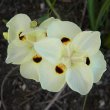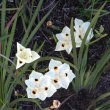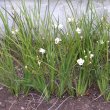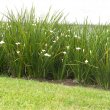| Botanical Name |
|
| Family |
Iridaceae - The iris family. |
| Pronunciation |
|
| Common Name(s) |
English: Yellow wild iris; Peacock Flower
Afrikaans: Uiltjie; Poublom
|
| Plant Group |
- Bulb / Corm / Rhizome / Tuber / Epigeal bulb Bulbs: are made up of fleshy scales as in an onion
Corm: a short, swollen, underground stem that is hard and not fleshy as in a gladiolus
Tuber: a solid, fleshy, underground, storage organ as in a potato
Rhizome: an underground, horizontal, swollen stem at the base of the plant as in an iris
Epigeal bulb: bulbs that rest above the ground with only the roots anchoring the plant to the earth as in albuca
- Ground Cover A plant with a low-growing, spreading habit, grown specifically to cover the ground.
|
| Plant Size |
- Medium to Large
| Tree | 15m to 20m |
| Shrub | 2m to 3m |
| Perennial/ground cover | 60cm to 75cm |
| Bulb | 60cm to 1m |
| Succulent | 60cm to 1m |
|
| Position |
- Light or Dappled Shade Found below trees with sparse, open foliage. Ideal for the protection of herbaceous plants.
- Partial Shade The area is in shade for part of the day and in full sun for part of the day.
- Sun The area is in full sun for all or most of the day, all year round.
|
| General Information |
- Drought Tolerance: High The plant is well adapted to arid conditions; it can survive long periods of drought and high temperatures without extra water.
- Evergreen Plants that have leaves all year round.
- Frost: Hardy The plant can withstand freezing temperatures or frost without artificial protection.
- Sand tolerant Plants adapted to survive in nutrient poor, very sandy soils.
- Water Wise Plant species originating from low rainfall regions that require less water to survive and thrive than other plant species.
- Wind Tolerant Plants able to withstand the effect of strong winds.
|
| Specific Information |
Dietes bicolor is an erect clump forming perennial which grows from a rhizome situated reasonable shallowly beneath the soil. The meter long, light green, sword shaped leaves are arranged in a fan. In a very dry situation the leaves become yellowed, adding colour and interest.
|
| Ad Break |
|
| Flowers |
| Description |
flattened, about 60mm in diameter with three brown markings or 'eyes'
|
| Season |
- Spring to Summer Plants will seldom bloom for the entire season as given in the list, but should flower during a period within these parameters.
|
| Colour |
|
| Growth Rate |
- Moderate to Fast Specifying growth rate can be very misleading as there is considerable variation of growth rate depending on type and species of plant, available water, supplementary feeding, mulching and general care, as well as the plants suitability and adaptability to the garden environment.
|
| Plant Uses |
- Attracts bees, butterflies or other insects This plant attracts insects which can be food for birds or other creatures in your garden.
- Attracts Birds This plant will attract birds.
- Border A strip of ground, at the edge of a driveway or path in which ornamental plants or shrubs are planted.
- Filler Either a fast growing tree or shrub used temporarily to fill in an area while the permanent plants grow to a desired size, or a plant used to fill gaps in borders or beds.
- Ground Cover Low-lying plants that spread fast, require minimal maintenance, and cover large expanses or bare areas between bulbs or shrubs. They provide protection from erosion and drought and improve the visual appearance of the garden.
- Mass Planting Plants useful for filling a large area with just one or a few kinds of plants spaced close together. Creates a bold, dramatic effect and to reduces maintenance.
- Pioneer for new gardens A very fast growing plant, able to withstand hardship, that can be used to populate land that has recently been cleared of natural vegetation. These plants pave the way for slower-growing species by adding nutrients to the soil and creating leaf litter.
- Rock Garden An area constructed of larger rocks, arranged naturally, to emphasise the use of stones as a main element. Generally plants used do not need a lot of care.
- Stabilize Banks Plant is used to prevent soil erosion because their roots will form a mat that stabilizes the soil and keeps it from washing away in heavy rains.
- Suitable for coastal gardens Plants adapted to dry, sandy soil, forceful wind, limited rainfall and intense sunlight.
- Water Features These plants may have dramatic, lush foliage or graceful form. They do not shed excessive leaves and do not have invasive root systems.
- Wild Garden An indigenous garden planted for the benefit of wildlife and birds. Provides food, water, a variety of mini-biomes and no poisonous chemicals are used.
- Windbreak Trees planted in a row to form protection from prevailing winds by breaking the force of the wind, thereby reducing wind damage.
|
| Distribution and Habitat |
in the Eastern Cape from the Grahamstown and Bathurst region to East London, near streams and in marshy places
|
| Planting Suggestions |
Dietes is able to grow easily in very poor soil with little water and can be useful when plants need to be established quickly, for example, after earth moving has taken place. For optimal results plant in soil containing plenty of compost and water regularly. Plant in light shade only in hot, inland regions. When separated and re-planted, these plants take a while to recover, but once established they are very fast growing. Mulch well and water regularly and generously until obvious signs of new growth are evident.
|
| Medicinal Uses |
The roots of Dietes bicolor were traditionally worn to protect and strengthen the wearer.
|
| Ad Break |
|









Comments
Will dieted buckling grow
Will dieted buckling grow well in ful sun?
Dietes bicolor in sun
Hi Shireen
Yes this plant will grow in full sun, unless in a very dry area such as the Karoo, or where temperatures regularly go over 30 degrees Celcius in summer.
Regards
Lorraine
Hi can anyone advise me how
Hi can anyone advise me how much should I cut back Dietes Bicolor when transplanting ?
Transplanting dietes
Hi Jeannine
I cut off two thirds of the leaves on mature plants and halfway down for very young plants.
Regards
Lorraine
Discuss this plant
Share knowledge, ask a question or give an experience.